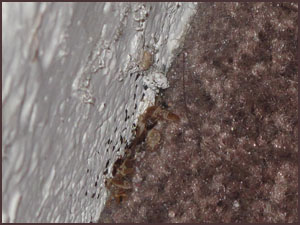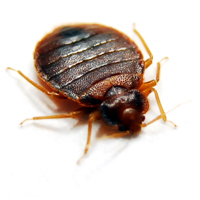Bed bug species
 Bed bugs are remarkable examples of evolution in action. Some species are in evolutionary stasis, but the bed bug is active and never static, this process of constant change and adaptation being a requirement if a bug is going to survive by targeting a human being.
Bed bugs are remarkable examples of evolution in action. Some species are in evolutionary stasis, but the bed bug is active and never static, this process of constant change and adaptation being a requirement if a bug is going to survive by targeting a human being.
It has occurred to me that every attempt to force bed bugs into extinction has failed, since such violent tactics contradict the interests of the bed bug, since bed bugs are driven by a powerful instinct to survive. For this reason I have come up with an idea which would involve eliciting the cooperation of bed bugs rather than inspiring the resistance of bed bugs, which is all we ever accomplish with chemical spraying.
 When bed bugs are raised in laboratories they are kept alive by feeding them through the use of membranes containing either pig or chicken blood. Since bed bugs were once sap suckers instead of blood suckers like they are now, it has occurred to me that given how evolutionary active this species, it would be an interesting experiment in living evolution to begin the process of weaning bed bugs off of human blood and back onto plant sap. For you see, bed bugs are just bugs and they are currently trapped in an endless cycle of battling with some unwilling human host for the blood they now require if their species is to survive. Since a human being is the partner of that bug in this symbiotic relationship, and since it is the human who has all the brains in that symbiotic relationship, it should be possible for the human being to use those brains to train bed bugs to find a new food source, and thus bring the battle between bed bugs and human beings to a permanent end, by '˜exterminating' the bed bug species by weaning them off of human blood.
When bed bugs are raised in laboratories they are kept alive by feeding them through the use of membranes containing either pig or chicken blood. Since bed bugs were once sap suckers instead of blood suckers like they are now, it has occurred to me that given how evolutionary active this species, it would be an interesting experiment in living evolution to begin the process of weaning bed bugs off of human blood and back onto plant sap. For you see, bed bugs are just bugs and they are currently trapped in an endless cycle of battling with some unwilling human host for the blood they now require if their species is to survive. Since a human being is the partner of that bug in this symbiotic relationship, and since it is the human who has all the brains in that symbiotic relationship, it should be possible for the human being to use those brains to train bed bugs to find a new food source, and thus bring the battle between bed bugs and human beings to a permanent end, by '˜exterminating' the bed bug species by weaning them off of human blood.
 My proposal for such an experiment would involve diluting the blood contained in feeding membranes with a small amount of sap from plants. With each generation of bed bugs produced, the amount of sap would be increased and the amount of blood gradually reduced. Since bed bugs are such adaptable creatures, given enough time, and enough generations of bed bugs, I would expect their to emerge at the end of the experiment a strain of '˜plant bugs' which is where bed bugs first began their evolutionary journey, and where they must return.
My proposal for such an experiment would involve diluting the blood contained in feeding membranes with a small amount of sap from plants. With each generation of bed bugs produced, the amount of sap would be increased and the amount of blood gradually reduced. Since bed bugs are such adaptable creatures, given enough time, and enough generations of bed bugs, I would expect their to emerge at the end of the experiment a strain of '˜plant bugs' which is where bed bugs first began their evolutionary journey, and where they must return.
Such an approach has never been attempted, and if I had the money to fund the experiment myself, I would begin today, because I am convinced this approach would work, and it is certainly worth making an attempt.
Some bed bug species are parasites of bats or birds, and may bite people if the wild hosts are no longer available. If bat bugs or bird bugs are involved, roosting and nesting sites should be the primary focus of treatment and the animals excluded from the building. The common bed bug, Cimex lectularius, is the species most adapted to living with humans. It has done so since ancient times. Bed bugs are mentioned in medieval European texts and in classical Greek writings back to the time of Aristotle. Other bed bug species prefer to feed on wild hosts, especially bats and birds.
AC_AX_RunContent( 'width','494','height','394','align','left','style','margin-right:3px;','src','https://www.youtube.com/v/YgZ9mAxAke0&hl=en_US&fs=1&','type','application/x-shockwave-flash','allowscriptaccess','always','allowfullscreen','true','movie','https://www.youtube.com/v/YgZ9mAxAke0&hl=en_US&fs=1&' ); //end AC code All of these species are generally similar in appearance. They are reddish-brown to grayish-brown with an oval body form and about 3/8-in long when full-grown. All are wingless, although small wing pads are present on the back. Their body is flattened when unfed, although they swell rapidly with a blood meal.
 When bedbugs are raised in laboratories they are kept alive by feeding them through the use of membranes containing either pig or chicken blood. Since bedbugs were once sap suckers instead of blood suckers like they are now, it has occurred to me that given how evolutionary active this species, it would be an interesting experiment in living evolution to begin the process
When bedbugs are raised in laboratories they are kept alive by feeding them through the use of membranes containing either pig or chicken blood. Since bedbugs were once sap suckers instead of blood suckers like they are now, it has occurred to me that given how evolutionary active this species, it would be an interesting experiment in living evolution to begin the process  of weaning bedbugs off of human blood and back onto plant sap. For you see, bedbugs are just bugs and they are currently trapped in an endless cycle of battling with some unwilling human host for the blood they now require if their species is to survive. Since a human being is the partner of that bug in this symbiotic relationship, and since it is the human who has all the brains in that symbiotic relationship, it should be possible for the human being to use those brains to train bedbugs to find a new food source, and thus bring the battle between bedbugs and human beings to a permanent end, by '˜exterminating' the bedbug species by weaning them off of human blood.
of weaning bedbugs off of human blood and back onto plant sap. For you see, bedbugs are just bugs and they are currently trapped in an endless cycle of battling with some unwilling human host for the blood they now require if their species is to survive. Since a human being is the partner of that bug in this symbiotic relationship, and since it is the human who has all the brains in that symbiotic relationship, it should be possible for the human being to use those brains to train bedbugs to find a new food source, and thus bring the battle between bedbugs and human beings to a permanent end, by '˜exterminating' the bedbug species by weaning them off of human blood.
 The mouthparts of bed bugs are especially adapted for piercing skin and sucking blood. Like most blood sucking arthropods, they inject saliva during feeding, which has anticoagulant properties. Bed bugs respond to the warmth and carbon dioxide of a host and quickly locate a suitable feeding site. They tend not to live on humans and the only contact is for a blood meal. Most blood feeding occurs at night, and they generally seek shelter during the day and become inactive while digesting the blood meal. However, bed bugs are opportunistic and will bite in the day especially if starved for some time. They can survive for long periods without feeding. While their preferred host is human, they will feed on wide variety of other warm-blooded animals including rodents, rabbits, bats, and even birds.
The mouthparts of bed bugs are especially adapted for piercing skin and sucking blood. Like most blood sucking arthropods, they inject saliva during feeding, which has anticoagulant properties. Bed bugs respond to the warmth and carbon dioxide of a host and quickly locate a suitable feeding site. They tend not to live on humans and the only contact is for a blood meal. Most blood feeding occurs at night, and they generally seek shelter during the day and become inactive while digesting the blood meal. However, bed bugs are opportunistic and will bite in the day especially if starved for some time. They can survive for long periods without feeding. While their preferred host is human, they will feed on wide variety of other warm-blooded animals including rodents, rabbits, bats, and even birds.
Being a cryptic species, bed bugs shelter in a variety of dark locations, mostly close to where people sleep. These include under mattresses, floorboards, paintings and carpets, behind skirting, in various cracks and crevices of walls, within bed frames and other furniture, and behind loose wallpaper. Bed bugs tend to stay in close contact with each other and heavy infestations are accompanied by a distinctive sweet sickly smell. Blood spotting on mattresses and nearby furnishings is often a tell tale sign of an infestation.
- Treating Bed Bug With chemicals [Last Updated On: September 19th, 2022] [Originally Added On: September 19th, 2022]
- Symptoms Picture Gallery [Last Updated On: September 20th, 2022] [Originally Added On: September 20th, 2022]
- Bed Bug Products [Last Updated On: September 21st, 2022] [Originally Added On: September 21st, 2022]
- Simplified Bed Bug Preparation [Last Updated On: September 22nd, 2022] [Originally Added On: September 22nd, 2022]
- Quality Pest Control Methods [Last Updated On: September 23rd, 2022] [Originally Added On: September 23rd, 2022]
- Pajamas Diminish Bed Bug Bites [Last Updated On: September 24th, 2022] [Originally Added On: September 24th, 2022]
- Bed Bug Picture Gallery [Last Updated On: September 25th, 2022] [Originally Added On: September 25th, 2022]
- Pesticides [Last Updated On: September 26th, 2022] [Originally Added On: September 26th, 2022]
- Male and Female Bed Bugs [Last Updated On: September 27th, 2022] [Originally Added On: September 27th, 2022]
- Affordable Bed Bug Registry Detection Method [Last Updated On: September 28th, 2022] [Originally Added On: September 28th, 2022]
- Introduction About Bed Bug [Last Updated On: September 29th, 2022] [Originally Added On: September 29th, 2022]
- Insect Bed Bug [Last Updated On: September 30th, 2022] [Originally Added On: September 30th, 2022]
- Welcome to Bed Bug Registry Database [Last Updated On: December 3rd, 2022] [Originally Added On: October 1st, 2022]
- How to Kill Bed Bugs [Last Updated On: October 2nd, 2022] [Originally Added On: October 2nd, 2022]
- How Bed Bug Bite [Last Updated On: October 3rd, 2022] [Originally Added On: October 3rd, 2022]
- Get Rid of Bed Bugs [Last Updated On: October 4th, 2022] [Originally Added On: October 4th, 2022]
- DDT for Bed Bugs [Last Updated On: October 5th, 2022] [Originally Added On: October 5th, 2022]
- Control Bed Bugs [Last Updated On: October 6th, 2022] [Originally Added On: October 6th, 2022]
- Contact Us [Last Updated On: October 7th, 2022] [Originally Added On: October 7th, 2022]
- Box Spring Treatment [Last Updated On: October 8th, 2022] [Originally Added On: October 8th, 2022]
- Bed Bug Products [Last Updated On: October 9th, 2022] [Originally Added On: October 9th, 2022]
- Bed Bug Products [Last Updated On: October 10th, 2022] [Originally Added On: October 10th, 2022]
- Bed Bug Wall or Baseboard [Last Updated On: October 11th, 2022] [Originally Added On: October 11th, 2022]
- Bed Bug Videos [Last Updated On: December 5th, 2022] [Originally Added On: October 12th, 2022]
- Bed Bug Treatment Synergy [Last Updated On: October 13th, 2022] [Originally Added On: October 13th, 2022]
- Bed Bug Treatment and Removal, How it is done [Last Updated On: October 14th, 2022] [Originally Added On: October 14th, 2022]
- Bed Bug Transmit Disease [Last Updated On: October 15th, 2022] [Originally Added On: October 15th, 2022]
- Bed Bug Tape [Last Updated On: October 16th, 2022] [Originally Added On: October 16th, 2022]
- Bed Bug Products [Last Updated On: October 17th, 2022] [Originally Added On: October 17th, 2022]
- Bed Bug Sniffing Dogs [Last Updated On: October 18th, 2022] [Originally Added On: October 18th, 2022]
- Bed Bug Spray - Non Toxic [Last Updated On: October 19th, 2022] [Originally Added On: October 19th, 2022]
- Bed Bug Products [Last Updated On: October 21st, 2022] [Originally Added On: October 21st, 2022]
- Bed Bug Products [Last Updated On: October 22nd, 2022] [Originally Added On: October 22nd, 2022]
- Bed Bug Repellent [Last Updated On: October 24th, 2022] [Originally Added On: October 24th, 2022]
- Bed Bug Products [Last Updated On: October 25th, 2022] [Originally Added On: October 25th, 2022]
- Bed Bug Products [Last Updated On: October 26th, 2022] [Originally Added On: October 26th, 2022]
- Bed Bug Products [Last Updated On: October 27th, 2022] [Originally Added On: October 27th, 2022]
- Bed Bug Pillow Case Encasement Covers [Last Updated On: October 29th, 2022] [Originally Added On: October 29th, 2022]
- Bed Bug Products [Last Updated On: October 30th, 2022] [Originally Added On: October 30th, 2022]
- Bed Bug Network [Last Updated On: October 31st, 2022] [Originally Added On: October 31st, 2022]
- Bed Bug Molting [Last Updated On: November 1st, 2022] [Originally Added On: November 1st, 2022]
- Bed Bug Mattress Encasement Protector Covers [Last Updated On: November 2nd, 2022] [Originally Added On: November 2nd, 2022]
- Bed Bug Look Like [Last Updated On: November 3rd, 2022] [Originally Added On: November 3rd, 2022]
- Advanced Bed Bug Preparation [Last Updated On: November 4th, 2022] [Originally Added On: November 4th, 2022]
- Bed Bug Wall or Baseboard [Last Updated On: November 5th, 2022] [Originally Added On: November 5th, 2022]
- Bedbug Legislation [Last Updated On: November 6th, 2022] [Originally Added On: November 6th, 2022]
- Bed bug Knowledge [Last Updated On: November 7th, 2022] [Originally Added On: November 7th, 2022]
- Bed Bug Products [Last Updated On: November 8th, 2022] [Originally Added On: November 8th, 2022]
- Bedbug in Hotel [Last Updated On: November 9th, 2022] [Originally Added On: November 9th, 2022]
- Bedbuig in Clothes, Fabrics [Last Updated On: November 11th, 2022] [Originally Added On: November 11th, 2022]
- Bedbug History [Last Updated On: November 12th, 2022] [Originally Added On: November 12th, 2022]
- Bedbug Hiding PLaces [Last Updated On: November 13th, 2022] [Originally Added On: November 13th, 2022]
- Bed Bug Nesting Location [Last Updated On: November 14th, 2022] [Originally Added On: November 14th, 2022]
- Bed Bug Products [Last Updated On: November 15th, 2022] [Originally Added On: November 15th, 2022]
- Bedbug Feedings [Last Updated On: November 16th, 2022] [Originally Added On: November 16th, 2022]
- Bed Bug Products [Last Updated On: November 17th, 2022] [Originally Added On: November 17th, 2022]
- Bedbug Epidemic [Last Updated On: December 3rd, 2022] [Originally Added On: November 18th, 2022]
- Bed Bug Eggs and Nymphs [Last Updated On: November 19th, 2022] [Originally Added On: November 19th, 2022]
- Bed Bug Distribute [Last Updated On: November 20th, 2022] [Originally Added On: November 20th, 2022]
- Bed Bug Discrimination [Last Updated On: November 21st, 2022] [Originally Added On: November 21st, 2022]
- Bed Bug Products [Last Updated On: November 22nd, 2022] [Originally Added On: November 22nd, 2022]
- Bed Bug Colony [Last Updated On: November 23rd, 2022] [Originally Added On: November 23rd, 2022]
- Bed Bug Products [Last Updated On: November 24th, 2022] [Originally Added On: November 24th, 2022]
- Bed Bug Products [Last Updated On: November 25th, 2022] [Originally Added On: November 25th, 2022]
- Bed Bug Box Spring Encasement Covers [Last Updated On: November 26th, 2022] [Originally Added On: November 26th, 2022]
- Bed Bug Bites Pictures [Last Updated On: November 27th, 2022] [Originally Added On: November 27th, 2022]
- Bedbug Bites [Last Updated On: December 3rd, 2022] [Originally Added On: November 28th, 2022]
- Bed Bug Products [Last Updated On: November 29th, 2022] [Originally Added On: November 29th, 2022]
- Bed Bug Products [Last Updated On: December 3rd, 2022] [Originally Added On: November 30th, 2022]
- Allergy Sentry Box Spring Encasement [Last Updated On: December 1st, 2022] [Originally Added On: December 1st, 2022]
- Affordable Bed Bug Detection Method [Last Updated On: December 5th, 2022] [Originally Added On: December 2nd, 2022]
- Advanced Bed Bug Preparation [Last Updated On: December 3rd, 2022] [Originally Added On: December 3rd, 2022]
- Adult Bed Bugs [Last Updated On: December 3rd, 2022] [Originally Added On: December 4th, 2022]


